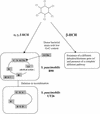Cloning and characterization of lin genes responsible for the degradation of Hexachlorocyclohexane isomers by Sphingomonas paucimobilis strain B90
- PMID: 12450824
- PMCID: PMC134425
- DOI: 10.1128/AEM.68.12.6021-6028.2002
Cloning and characterization of lin genes responsible for the degradation of Hexachlorocyclohexane isomers by Sphingomonas paucimobilis strain B90
Abstract
Hexachlorocyclohexane (HCH) has been used extensively against agricultural pests and in public health programs for the control of mosquitoes. Commercial formulations of HCH consist of a mixture of four isomers, alpha, beta, gamma, and delta. While all these isomers pose serious environmental problems, beta-HCH is more problematic due to its longer persistence in the environment. We have studied the degradation of HCH isomers by Sphingomonas paucimobilis strain B90 and characterized the lin genes encoding enzymes from strain B90 responsible for the degradation of HCH isomers. Two nonidentical copies of the linA gene encoding HCH dehydrochlorinase, which were designated linA1 and linA2, were found in S. paucimobilis B90. The linA1 and linA2 genes could be expressed in Escherichia coli, leading to dehydrochlorination of alpha-, gamma-, and delta-HCH but not of beta-HCH, suggesting that S. paucimobilis B90 contains another pathway for the initial steps of beta-HCH degradation. The cloning and characterization of the halidohydrolase (linB), dehydrogenase (linC and linX), and reductive dechlorinase (linD) genes from S. paucimobilis B90 revealed that they share approximately 96 to 99% identical nucleotides with the corresponding genes of S. paucimobilis UT26. No evidence was found for the presence of a linE-like gene, coding for a ring cleavage dioxygenase, in strain B90. The gene structures around the linA1 and linA2 genes of strain B90, compared to those in strain UT26, are suggestive of a recombination between linA1 and linA2, which formed linA of strain UT26.
Figures






Similar articles
-
Enantioselective transformation of alpha-hexachlorocyclohexane by the dehydrochlorinases LinA1 and LinA2 from the soil bacterium Sphingomonas paucimobilis B90A.Appl Environ Microbiol. 2005 Dec;71(12):8514-8. doi: 10.1128/AEM.71.12.8514-8518.2005. Appl Environ Microbiol. 2005. PMID: 16332842 Free PMC article.
-
Organization of lin genes and IS6100 among different strains of hexachlorocyclohexane-degrading Sphingomonas paucimobilis: evidence for horizontal gene transfer.J Bacteriol. 2004 Apr;186(8):2225-35. doi: 10.1128/JB.186.8.2225-2235.2004. J Bacteriol. 2004. PMID: 15060023 Free PMC article.
-
Dynamics of multiple lin gene expression in Sphingomonas paucimobilis B90A in response to different hexachlorocyclohexane isomers.Appl Environ Microbiol. 2004 Nov;70(11):6650-6. doi: 10.1128/AEM.70.11.6650-6656.2004. Appl Environ Microbiol. 2004. PMID: 15528530 Free PMC article.
-
Aerobic degradation of lindane (gamma-hexachlorocyclohexane) in bacteria and its biochemical and molecular basis.Appl Microbiol Biotechnol. 2007 Sep;76(4):741-52. doi: 10.1007/s00253-007-1066-x. Epub 2007 Jul 19. Appl Microbiol Biotechnol. 2007. PMID: 17634937 Review.
-
Comprehensive review on Haloalkane dehalogenase (LinB): a β-hexachlorocyclohexane (HCH) degrading enzyme.Arch Microbiol. 2024 Aug 14;206(9):380. doi: 10.1007/s00203-024-04105-1. Arch Microbiol. 2024. PMID: 39143366 Review.
Cited by
-
Crystal structure of the hexachlorocyclohexane dehydrochlorinase (LinA-type2): mutational analysis, thermostability and enantioselectivity.PLoS One. 2012;7(11):e50373. doi: 10.1371/journal.pone.0050373. Epub 2012 Nov 27. PLoS One. 2012. PMID: 23209726 Free PMC article.
-
Comparative metagenomic analysis of soil microbial communities across three hexachlorocyclohexane contamination levels.PLoS One. 2012;7(9):e46219. doi: 10.1371/journal.pone.0046219. Epub 2012 Sep 28. PLoS One. 2012. PMID: 23029440 Free PMC article.
-
Purification and characterization of a three-component salicylate 1-hydroxylase from Sphingomonas sp. strain CHY-1.Appl Environ Microbiol. 2007 Dec;73(23):7515-21. doi: 10.1128/AEM.01519-07. Epub 2007 Sep 28. Appl Environ Microbiol. 2007. PMID: 17905882 Free PMC article.
-
Genetic analysis of phenoxyalkanoic acid degradation in Sphingomonas herbicidovorans MH.Appl Environ Microbiol. 2004 Oct;70(10):6066-75. doi: 10.1128/AEM.70.10.6066-6075.2004. Appl Environ Microbiol. 2004. PMID: 15466552 Free PMC article.
-
Genomic Analysis of γ-Hexachlorocyclohexane-Degrading Sphingopyxis lindanitolerans WS5A3p Strain in the Context of the Pangenome of Sphingopyxis.Genes (Basel). 2019 Sep 6;10(9):688. doi: 10.3390/genes10090688. Genes (Basel). 2019. PMID: 31500174 Free PMC article.
References
-
- Altschul, S. F., W. Gish, W. Miller, E. W. Myers, and D. J. Lipman. 1990. Basic local alignment search tool. J. Mol. Biol. 215:403-410. - PubMed
-
- Bhuyan, S., B. Sreedharan, T. K. Adhya, and N. Sethunathan. 1993. Enhanced biodegradation of γ-hexachlorocyclohexane (γ-HCH) in HCH (commercial) acclimatized flooded soil: factors affecting its development and persistence. Pestic. Sci. 38:49-55.
-
- Cerkvenik, V., D. Z. Doganoc, and J. Jan. 2000. Evidence of some trace elements, organochlorines pesticides and PCBs in Slovenian cow's milk. Food Technol. Biotechnol. 38:155-160.
-
- Imai, R., Y. Nagata, K. Senoo, H. Wada, M. Fukuda, M. Takagi, and K. Yano. 1989. Dehydrochlorination of γ-hexachlorocyclohexane (γ-BHC) by γ-BHC-assimilating Pseudomonas paucimobilis. Agric. Biol. Chem. 53:2015-2017.
Publication types
MeSH terms
Substances
LinkOut - more resources
Full Text Sources

